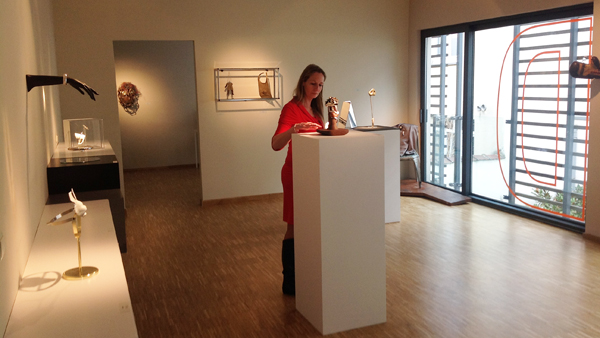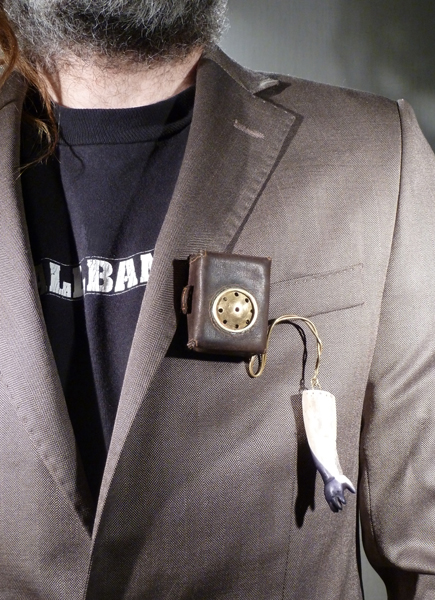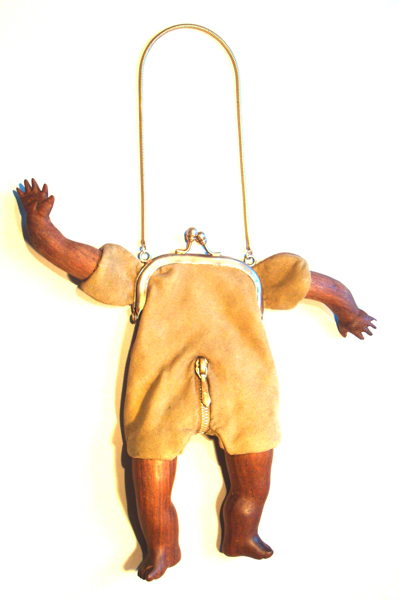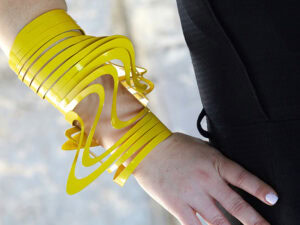
Susan Cummins: You are really new on the scene. Can you give me some background what lead you to decide to open a jewelry gallery?
Françoise Vanderauwera: Yes, I am very new on the scene. I knew four years ago that I wanted to open a gallery to show much more of these wonderful artworks to a wider public. The starting point for me was design. I grew up using cutlery by the architect-designer Arne Jacobsen, which my father, who was also an architect, received personally from him. A few years ago, when a Brussels design shop I used to visit closed I began looking for contemporary creators and was amazed by how many high profile gold- and silversmiths, object designers and new jewelers I could recognize. I learned and traveled a lot and now the gallery is up and running.

Susan Cummins: You are really new on the scene. Can you give me some background what lead you to decide to open a jewelry gallery?
Françoise Vanderauwera: Yes, I am very new on the scene. I knew four years ago that I wanted to open a gallery to show much more of these wonderful artworks to a wider public. The starting point for me was design. I grew up using cutlery by the architect-designer Arne Jacobsen, which my father, who was also an architect, received personally from him. A few years ago, when a Brussels design shop I used to visit closed I began looking for contemporary creators and was amazed by how many high profile gold- and silversmiths, object designers and new jewelers I could recognize. I learned and traveled a lot and now the gallery is up and running.

Françoise Vanderauwera: I definitely want to show artwork that makes people think and doesn’t leave them indifferent. A political science education and my professional experiences helped me acquire a critical state of mind about our modern society. Compared to that, art now sounds to me like the right expression of our time, at least! Thus the criteria I am using to determine what to show are expressions of our time. The work is honest, poetic and strong and made with an exactness in the chosen material and techniques.
You say you are committed to promoting research and development in contemporary art jewelry on your website. How are you planning to do that?

Do you believe that the publication of texts will help the marketplace?
Françoise Vanderauwera: Yes, the publication of texts helps the marketplace. In Belgium there is still a lot to do to make people aware of contemporary art jewelry, I am under the impression we still haven’t touched all the spheres (journalists, politics, collectors, visitors, etc). This is very challenging for a gallery.
Delphine, your show at Vander A Contemporary Art Jewellery is fascinating. Can you give me some background on how you became interested in art jewelry? Did you study it at University?
Delphine Joly: I began my studies with styling at the Brussels Francisco Ferrer High School. I then worked for ten years as a wardrobe master for circus, theater, cinema and marionette where I realized that the most expressive part of a silhouette is the accessory. This is the reason why I recently completed my study with jewelry at the Brussels Institute of Arts and Crafts.

Delphine Joly: I was born in Brussels and I have always lived there.
Who are your mentors?
Delphine Joly: I have never had a mentor.
Your pieces seem very surreal to me. Is surrealism a source of inspiration to you?
Delphine Joly: I think that it is because of my working process. My university is the therapy room. At school I have mainly learned the techniques. My creative process is an inner process where the dream and the unconscious are very important.

Delphine Joly: The title Jewels Stories for this exhibition came from the movie Toy Story. Each jewel embodies a person, a character with a personality. Maryline is a design object that comes apart, forming two pendants and one bracelet. The central element is a medication package with movable doll eyes. The rocking, the tears and the very thin structure, which supports a massive pendant, achieves an edgy aspect. The second pendant collects tears and represents the public. Le Cri is the shout is associated with the first breath and it proves that we are alive. With Primal, when you press on the button, the jewel shouts a mechanical sound ‘mom.’ It expresses a dysfunction between the machine and the human’s nature. The device works. The thread is connected but something is strange. La Faim et Les Moyens is two jewels for one idea. The world is divided in two groups: those who are hungry and who are transformed into marionettes and those who have the means to eat and are represented by a necklace bib symbolizing infantilism and force-feeding.

Delphine Joly: Regis Masson is musician with the band Pneumatic Head Compressor and co-founder of an alternative music place in Brussels, called Le Magasin 4. He is a scenographer, sculptor, lighting designer and my boyfriend. We speak at home and afterwards he places the pieces where he feels they belong.
What book or movie has affected you recently?
Delphine Joly: In terms of books, Kafka Sur Le Rivage by Murakami. In terms of movies, Dogteeth and Morse.
What music do you usually listen to while you are working?
Delphine Joly: I listen audio literature when I am working.





